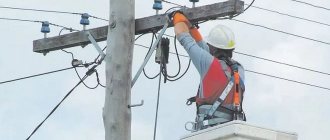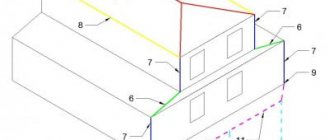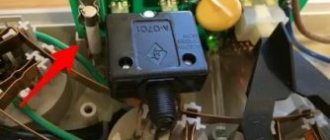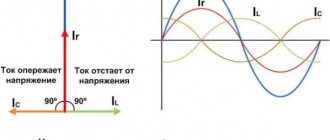Security zones for power lines
Near a broken wire Back to top Near existing electrical installations
Security zones are established for all power grid facilities:
Security zones along overhead power lines (hereinafter referred to as OHL).
- The upper limit is the height of the overhead line supports.
- Lateral boundaries are measured from the outermost wires. Depends on the overhead line voltage and wire type. Self-supporting insulated wire (SIP) has a higher safety class due to its insulating coating.
| Voltage, kV | Voltage, kV |
| up to 1 | up to 1 |
| 1 — 20 | 1 — 20 |
| 35 | 35 |
| 110 | 110 |
| 150- 220 | 150- 220 |
| 300-750 | 300-750 |
| 750-1150 | 750-1150 |
| 1150 | 1150 |
Security zones along underground cable power lines.
- The lower limit is equal to the depth of laying cable power lines.
- Lateral borders - on both sides of the outer cables at a distance of 1 m.
- The security zone of cable lines with voltage up to 1 kV under city sidewalks towards buildings is 0.6 m.
Security zones of submarine cable power lines
- The lower boundary is the bottom.
- Lateral boundaries - on both sides of the line from the outermost cables at a distance of 100 m.
Security zones when overhead power lines cross water bodies
- The upper limit is the height of the overhead line supports.
- Lateral borders - on both sides of the outer wires at a distance of:
- for navigable reservoirs - 100 m. - for non-navigable reservoirs - at the distance provided for the establishment of security zones along overhead power lines (see clause 1).
Safety rules in security zones of power lines are regulated by the Rules for the establishment of security zones of electric grid facilities and special conditions for the use of land plots located within the boundaries of such zones (approved by Decree of the Government of the Russian Federation of February 24, 2009 N 160)
In security zones of power lines it is prohibited:
- throw foreign objects onto the wires and supports of overhead power lines;
- climb the supports of overhead power lines;
- fly any aircraft, including kites and sports model aircraft;
- light a fire within the security zones of input and distribution devices, substations, overhead power lines, as well as in the security zones of cable power lines near the security zones. Wind direction and fire spread are unpredictable;
- perform work with impact mechanisms, drop heavy objects weighing over 5 tons in security zones of power facilities;
- discharge and drain caustic and corrosive substances and fuels and lubricants in security zones of power lines.
- storing and storing materials, including fuels and lubricants: - in the security zone of power lines over 1 kV is prohibited; - in the security zone of power lines up to 1 kV - only with the written permission of Rosseti Center. The application must be submitted no later than 2 weeks before the start of work;
- Place children's and sports grounds, stadiums, markets, retail outlets, field camps, livestock pens, garages and parking lots (except for parking garages for individuals), hold public events:
- in the security zone of power lines over 1 kV - prohibited;- in the security zone of power lines up to 1 kV - only with the written permission of Rosseti Center. The application must be submitted no later than 2 weeks before the start of work.
Near a broken wire Back to top Near existing electrical installations
Sanitary norms and rules for human activity and presence in the power line area
According to the rules of SNiP, a certain relationship has been established between the voltage class of power lines and the size of the security zone around the power line. In addition, sanitary rules clearly indicate what distance is considered acceptable between power lines and residential buildings or other economic facilities.
Safe distances are established in accordance with the power of the power line; according to sanitary standards, the permissible voltage level should not exceed 1.0 kV/m. Below is a table with current standards. The dependence of the exclusion zone on the power of the overhead line is clearly shown in the figure.
Safe distance from power lines, depending on the voltage class
In addition to sanitary standards, it is necessary to take into account the requirements of the PUE; it makes sense to consider them in detail.
PUE requirements
The 7th edition (R. 2, Chapter 2.5) specifies the following standards:
- If a 0.4 kV - 1 kV overhead line is located parallel to the gas pipeline, then the distance between them must exceed the height of the electrical support. In cases where the pipelines intersect, an ungrounded protective canopy (screen) is installed over the gas pipeline, protecting the pipeline in the event of a power line break. The width of the screen should extend beyond the projection of the external power line by a distance depending on the voltage class:
- For overhead lines 20.0 kV - 3.0 meters.
- Overhead line 35.0 kV – 110.0 kV – 4.0 m.
- 150.0 kV – 4.50 m.
- 220.0 kV – 5.0 m.
- 330.0 kV – 6.0 m.
- 500 kV – 6.50 m.
- Since power lines can pass over certain types of non-residential buildings (workshops, warehouses, etc.), the distance between them and external overhead lines is considered safe in the following cases:
- 20.0 kV – at least 2 meters.
- 35.0-110.0 kV – from 4 m.
- 150.0 kV > 5.0 m.
- 220.0 kV and more – 6.0 m.
At the same time, there are restrictions according to which the construction of schools, kindergartens, sports grounds, and other facilities with large numbers of people is prohibited in the exclusion zones.
- Power lines are prohibited from running over residential buildings, the only exception being input lines.
- Between the power line and a parallel road, a distance of at least X+5 m is allowed, where X is the height of the electrical support. In cases where the lines cross a road belonging to the 1st category, the installation of anchor supports is required.
- If electric mains pass near technological facilities where explosive or flammable substances are stored or used (for example, gas stations), then the permissible distance is determined by one and a half height of the electric support.
- The height of the power line from the ground is determined by the voltage class of the latter and the type of terrain; the permissible distances are given below.
Permissible distances from wires to ground
Please note that in populated areas, the permissible distance from wires to ground has been increased. Detailed information about this can be found in the latest edition of the PUE.
Security zones of power lines and power grid facilities. Zone sizes
The use of territories located in the power transmission line zone is regulated by the new Rules for the establishment of security zones of electric grid facilities and special conditions for the use of land plots located within the boundaries of such zones (Resolution of the Government of the Russian Federation No. 160 of February 24, 2009, as amended on May 17, 2016).
The introduction of such rules is due to the harmful effects of electromagnetic fields on human health.
According to the Center for Electromagnetic Safety, in accordance with the results of studies, it has been established that people living near power lines and transformer substations:
- changes in the functional state of the nervous, cardiovascular, neurohormoral and endocrine systems may occur
- metabolic processes, immunity and reproductive functions are disrupted
The farther the building is from the sources of the electromagnetic field, the better. At the same time, there are areas where construction is strictly prohibited.
Land plots located in security zones of power lines are not confiscated from their owners, owners or users.
They can be operated subject to the restrictions (encumbrances) provided for by the above Rules.
The establishment of security zones does not entail a ban on transactions with land plots located in these security zones.
Restrictions (encumbrances) must be indicated in documents certifying the rights of owners, possessors or users of land plots:
- in evidence
- in cadastral passports
- in USRN extracts
Restrictions on rights relate to the possibility (or rather, impossibility) of carrying out capital construction of facilities with long-term or permanent human presence in the power transmission line security zone:
- houses
- cottages
- industrial and non-industrial buildings and structures
To carry out the necessary clarifications when developing areas with power transmission line encumbrances, you must contact the electric grid organization.
The range of propagation of the electromagnetic field (and dangerous magnetic field) from the power line directly depends on its power.
Even with a quick glance at the hanging wires, you can approximately determine the voltage class of the power line. This is determined by the number of wires in the bundle, that is, not on the support, but in phase:
- 4 wires – for 750 kV power lines
- 3 wires – for 500 kV power lines
- 2 wires – for 330 kV power lines
- 1 wire – for power lines below 330 kV
You can roughly determine the voltage class of power lines by the number of insulators in the garland:
- 10 – 15 pcs. -– for 220 kV power lines
- 6 – 8 pcs. – for 110 kV power lines
- 3 – 5 pcs. – for 35 kV power lines
- 1 PC. – for power lines below 10 kV
Based on the power of power lines, to protect the population from the action of the electromagnetic field, sanitary protection zones have been established for power lines (clause 6.3 in SanPiN 2.2.1/2.1.1.1200-03 “Sanitary protection zones and sanitary classification of enterprises, structures and other objects”)
The dimensions of sanitary protection zones are determined in accordance with current sanitary and epidemiological standards for permissible levels of noise, electromagnetic radiation, infrasound, scattered laser radiation and other physical factors on the outer border of the sanitary protection zone.
In order to protect the population from the effects of the electric field created by overhead power lines (OHT), sanitary breaks are installed - areas along the high-voltage line route in which the electric field strength exceeds 1 kV/m.
For newly designed overhead lines, as well as buildings and structures, it is allowed to accept the boundaries of sanitary breaks along the overhead line route with horizontal wires and without means of reducing the electric field strength on both sides of it at the following distances from the projection onto the ground of the outer phase wires in the direction perpendicular to the overhead line:
- 20 m – for overhead lines with voltage 330 kV
- 30 m – for overhead lines with a voltage of 500 kV
- 40 m – for overhead lines with a voltage of 750 kV
- 55 m – for overhead lines with a voltage of 1150 kV
When putting an object into operation and during operation, the sanitary gap must be adjusted based on the results of instrumental measurements.
Establishing the size of sanitary protection zones in the locations of transmitting radio engineering facilities is carried out in accordance with:
- with current sanitary rules and regulations on electromagnetic radiation of the radio frequency range
- with current methods for calculating the intensity of electromagnetic radiation of radio frequencies
For overhead high-voltage power lines (OHTs), sanitary protection zones are installed on both sides of the projection of the outermost wires onto the ground.
These zones determine the minimum distances to the nearest residential, industrial and non-industrial buildings and structures.
In accordance with the Appendix “Requirements for the boundaries of establishing security zones of power grid facilities” to the Decree of the Government of the Russian Federation “On the procedure for establishing security zones of power grid facilities and special conditions for the use of land plots located within the boundaries of such zones” No. 160 dated February 24, 2009:
Security zones are established:
Along overhead power lines
in the form of a part of the surface of a plot of land and airspace to a height corresponding to the height of the overhead power line supports, limited by parallel vertical planes spaced on both sides of the power line from the outermost wires when their position is not deflected at the following distance:
- for overhead lines below 1 kV – 2 m for lines with self-supporting or insulated wires laid along the walls of buildings, structures, etc.
- the security zone is determined in accordance with the minimum permissible distances from such lines established by regulatory legal acts
- 10 m
- 15 m
- 20 m
- 25 m
- 30 m
- 40 m
- 55 m
Along underground cable power lines
- in the form of part of the surface of a plot of land, the subsoil plot located underneath it: to a depth corresponding to the depth of laying cable power lines
- limited by parallel vertical planes spaced on both sides of the power line from the outer cables at a distance of 1 m
Along submarine cable power lines
- in the form of a body of water from the water surface to the bottom
- the security zone is limited by vertical planes: spaced on both sides of the line from the outermost cables at a distance of 100 m
Along crossings of overhead power lines through bodies of water (rivers, canals, lakes, etc.)
- in the form of air space above the water surface of reservoirs to a height corresponding to the height of overhead power line supports
- are spaced on both sides of the DEP from the outermost wires when their position is not deviated for navigable bodies of water at a distance of 100 m
Around substations
- as part of the surface of the land and airspace: to a height corresponding to the height of the highest point of the substation
- are spaced from all sides of the substation perimeter fence at the distance specified in subparagraph “1” in relation to the highest voltage class of the substation
Establishment of security zones
Security zones are established for all power grid facilities, based on the requirements for the boundaries of establishing security zones in accordance with the appendix.
The boundaries of the security zone in relation to a separate power grid facility are determined by the organization that owns it by right of ownership or other legal basis (hereinafter referred to as the grid organization).
The grid organization applies to the federal executive body that carries out technical control and supervision in the electric power industry with an application for approval of the boundaries of the security zone in relation to individual electric grid facilities. It must be reviewed within 15 days from the date of its receipt by the relevant authority.
After agreeing on the boundaries of the security zone, the network organization applies to the federal executive body responsible for cadastral registration and maintenance of the state real estate cadastre (cadastral registration authority), with an application to include information about the boundaries of the security zone in the documents of the state cadastral registration of real estate. On this basis, the federal executive body makes a decision to include information about the boundaries of the security zone in the documents of the state cadastral registration of real estate.
The security zone is considered established from the date of entry into the state cadastral registration documents of information about its boundaries.
Note
- It is not allowed for power lines to pass through the following territories:
- stadiums
- educational institutions
- children's institutions
- It is allowed for power lines (overhead lines) up to 20 kV to take a distance of at least 20 m from the outermost wires to the boundaries of: household plots
- individual houses
- collective garden plots
- in accordance with building codes and rules for fire safety of buildings and structures with roofing made of non-combustible materials
In the security zone of power lines (VL) it is prohibited
- produce:
- construction
- major renovation
- demolition of any buildings and structures
- carry out all kinds of mining, blasting, reclamation work
- plant trees, water crops
- place gas stations
- block the entrances and approaches to overhead line supports
- arrange dumps of snow, garbage and soil
- store feed, fertilizer, straw
- spread the fire
- arrange sports grounds, stadiums, transport stops
- carry out any events involving large crowds of people
Carrying out the necessary measures in the security zone of power lines can only be carried out upon receipt of written permission to carry out work from the enterprise (organization) in charge of these networks.
Violation of the requirements of the “Rules for the protection of electrical networks with voltages over 1000 V”, if it caused an interruption in the supply of electricity, may entail administrative liability:
- individuals are punished with a fine: from 5 to 10 times the minimum wage
- from 100 to 200 minimum wage
What can be built in a water protection zone?
Construction in a water protection zone is permitted if water resources are not polluted or depleted during the construction of the facility or its operation. Subject to this rule, objects of almost any purpose can be placed in this zone. Anything that poses a danger to water bodies and other resources (service stations, cattle burial grounds, gas stations, etc.) is prohibited.
The construction of garden houses, individual residential properties, and auxiliary buildings is permitted, but with the caveat that all buildings must prevent pollution, siltation or depletion of the water body. To ensure the protection of water resources, a permanent building or other structure is equipped with:
- stormwater drainage system;
- centralized sewerage;
- waste collection facilities;
- water purification systems, etc.
If there are no treatment facilities on the territory of the SNT or gardening farm and it is not possible to connect houses to third-party treatment systems, the temporary use of waterproof containers is allowed. Their contents must be transported using special equipment.
The development of your own treatment system, or connection to a centralized sewerage system, is carried out by the owner of the site or the developer. If industrial enterprises are located within the water protection zone, it will be necessary to create a system for complete wastewater treatment. Any facilities erected on such a territory must comply with the requirements of state standards and SNiPs.
If you plan to build an individual residential building, you will have to provide a safe area for traffic and parking of vehicles. To do this, a hard surface is created that completely hides the soil and vegetation (the parking lot must be covered with a layer of asphalt). When the object is located in a forest that is part of a water protection zone, in addition to the restrictions listed above, you will have to be guided by the provisions of the Forest Code of the Russian Federation. The land lawyers of the Geobureau will help you understand the situation.
How to obtain permission to build in a protected zone of a cultural heritage site?
A building permit is issued by the local municipality to which the site belongs. But this document will not be issued unless there is approval from the authorized agency responsible for cultural heritage sites. As a rule, future construction must be coordinated with the Ministry of Culture and the state inspection for the protection of cultural heritage sites.
Before starting construction work, study the documents for the site to determine the presence of a security zone:
- If there is a cultural heritage object (CHO) on the territory, a project of actions to preserve it in its original form will be required to coordinate the construction;
- If the site is only included in the ZOOIT, but there is no such object here, it is necessary to obtain a conclusion about the absence of a cultural monument (it is issued after a historical and cultural examination).
The project of measures aimed at preserving the appearance of OKN is agreed upon by the Ministry of Culture. Here they receive a conclusion that there is no such object on the territory.
Contacting the government an inspection for the protection of OKN will make it possible to understand whether it is even possible to build within a certain territory and what exactly is allowed to be built here. If construction is permitted subject to certain conditions:
- the above project is being developed;
- documents for the site and the applicant are attached to it;
- and all this is sent to the Ministry of Culture;
- It will take about 30 days for approval.
The project confirms that the OKN façade, building codes within the protected area and other requirements will be preserved. If there is no cultural heritage site, it is enough to obtain a conclusion, collect a new list of documents and apply to the administration for a construction permit. If there is an object, the conclusion of the Ministry of Culture should be replaced with the results of project approval. To ensure that the permit is accurately issued, consult with the lawyers of our company or entrust them with the approvals.











